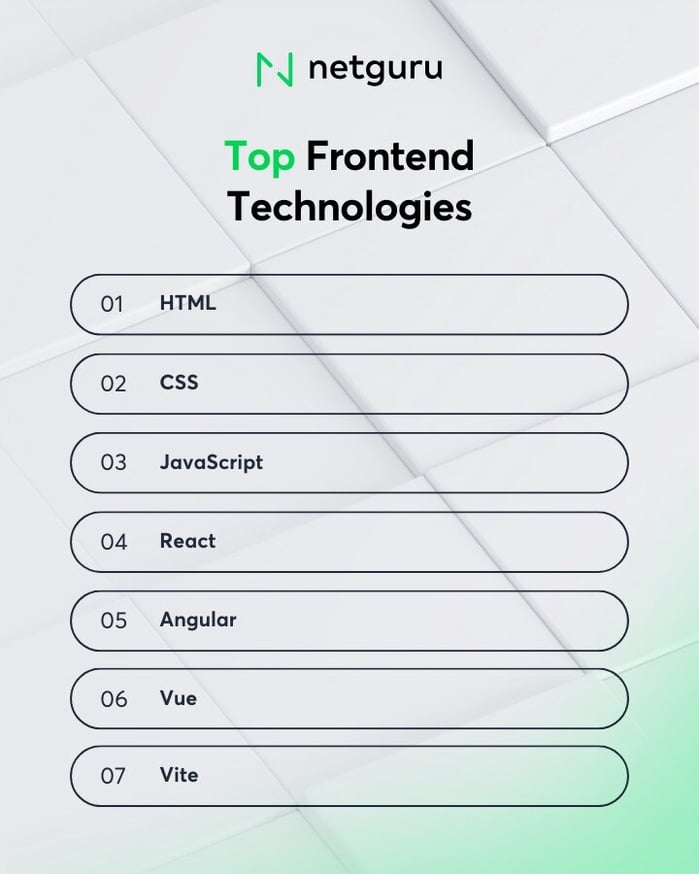24 Top Frontend Technologies to Use in 2025

When learning frontend development or selecting the tools for your new project, you will undoubtedly want to utilize the latest and most potent frontend technologies to create impressive and high-speed user interfaces.
Beyond the basics of HTML, CSS, and JavaScript, numerous potent technologies are available for front-end developers to build progressive web apps for both desktop and mobile devices. This article will explore two dozen viable front-end technologies to employ in 2025.
Short summary:
- Dive into a comprehensive overview of the top frontend technologies for 2025.
- Explore strategies for effectively balancing innovation and reliability in your technology choices.
- Discover key considerations to guide you in selecting the ideal frontend solutions that best suit your project requirements.
What are frontend and backend technologies?
To begin with — remember that there is a strict division between frontend and backend for web page development.Backend technologies are related to the server side of the applications. In turn, frontend relates to the browser and user interfaces/interactions. While both sides contribute equally to the project’s success, this article will focus on the top frontend options for your project.
List of top frontend technologies
“Top” technologies are often equated with the “latest” tools.
The latest tools may lack proper support, integration, or documentation, and it's important to consider the popularity and success of a technology, as seen in the cases of CSS and HTML, which, despite not being “new” or “emerging”, remain fundamental to frontend development.
This blog post presents a mix of well-established, emerging, and trendy technologies to provide a comprehensive overview of the current market.
1. HTML (HyperText Markup Language)
Let's begin with the basics: HTML is the foundation of frontend development and its importance is unlikely to diminish anytime soon. This technology enables you to create the structure or "markup" of your website, although it may not offer the most dynamic user interface, HTML elements provide you with basic tools to add buttons, forms, containers, and other features to web page.
2. CSS (Cascading Style Sheets)
Another core frontend technology, CSS allows you to add additional styling rules to the HTML structure you have created, ensuring that your web application is responsive and visually appealing with eye-catching animations that make it interactive and work seamlessly on any screen size or device.
3. JavaScript
JavaScript (JS) is a programming language that has always been and will continue to be one of the most important frontend technologies for web and mobile applications, allowing developers to dynamically modify the contents of both mobile and desktop apps and implement various features such as shopping carts, complex animations, tax calculators, web browser games, and more.
4. React
React is a JavaScript library that offers new syntax while still being powered by JavaScript, making it faster and easier to create web applications due to its declarative and component-based nature.
Originally designed by Facebook to enhance performance and maintenance for their internal use, it's now an open-source project with a vast community of the frontend developers, and is among the most popular JS tools.
5. Angular
Angular is a full-fledged JavaScript-based frontend framework supported by Google, and the modularity and component-based approach it provides have garnered a strong community among frontend developers worldwide.
Its simplicity makes this framework perfect for single-page applications, and though some developers say that it's a bit harder to learn Angular than React, it's definitely worth it as there is a high demand in the market for experts in this technology, with Angular developers demand showing predicted growth of approximately 31% between 2016 and 2026.
6. Vue
Vue is considered one of the best frontend options for single-page web applications, and is a JavaScript framework designed for creating user interfaces that provides a declarative and component-based programming experience, similar to React and Angular, with millions of weekly downloads on npm, demonstrating its popularity in the market.
7. Vite
Vite.js is a fast and lightweight build tool and development server designed for modern web development. It is specifically optimized for building web applications that use modern JavaScript frameworks like React, Vue.js, and Svelte. Vite.js achieves its speed by using an innovative development server that leverages native ES modules in the browser, enabling rapid hot module replacement and fast initial load times.
Additionally, Vite.js supports features like CSS preprocessing, TypeScript support, and a plugin system for extending its functionality.

8. Svelte and SvelteKit
According to the State of JS report at the end of 2022, Svelte is right behind the top trio (React, Angular, and Vue) in terms of retention, interest, and awareness. Svelte is a popular language for building web applications that allows developers to write reactive components that efficiently update the DOM. It uses a compiler to generate optimized JavaScript code, reducing the amount of code that needs to be downloaded and executed in the browser.
For easier access to the framework, SvelteKit is a framework built on top of Svelte that provides server-side rendering, routing, and other features to make it easier to build complex web applications. SvelteKit leverages the benefits of Svelte's reactive programming model and compiles the application code into a set of server-rendered and client-side JavaScript files optimized for performance.
9. Next
Next.js is a tool that helps you build super-fast websites with the help of React. Whether it's static site generation or server-side rendering, you can choose either approach depending on your project needs. The performance of web pages based on the Next.js framework is outstanding due to multiple optimization techniques it uses, like pre-rendering. Additionally, the framework is also SEO-friendly, which is a big advantage for online businesses and marketing projects.
10. TypeScript
Everyone with some frontend experience knows that JavaScript can be tricky and sometimes even dangerous when it comes to types. This is no longer the case with TypeScript.
It allows you to write regular JS with some additional syntax for type definitions. This technology is becoming a standard in modern frontend development as it allows TypeScript developers to save time when debugging type-based issues. Additionally, it makes the final software more stable.
TypeScript throws an error anytime we make a mistake related to variable types, so we can make proper adjustments before we receive bug reports from customers.
11. Gatsby
Gatsby is a framework that combines the best parts of React, GraphQL, and webpack. Thanks to Gatsby, you are able to build fast and responsive user interfaces for consumers while keeping the developer experience relatively pleasant. Additionally, it provides some out-of-the-box features like image optimization and code-splitting, allowing functions to be loaded on demand and improving the project’s performance. Gatsby’s data layer is based on GraphQL.
12. React Native
React Native is a React-based framework that allows you to create cross-platform mobile applications for iOS and Android platforms. Thanks to React Native, developing cross platform code is made easier and more accessible. Developers can create mobile applications that look and feel native to multiple platforms.
13. Flutter
Flutter is an open-source framework created by Google using the Dart programming language. Creating interactive UI elements is much easier using Flutter’s widgets, which allow you to create dynamic and interactive applications from pre-created templates.
With Flutter, web developers are able to create cross-platform applications for mobile devices with a single codebase and one programming language.
14. Astro
Astro is a new MPA (Modular Page Applications) framework that aims to simplify the process of building and deploying web applications, allowing developers to use any of the popular frameworks to develop them.
Astro's strengths include its fast build times and ability to easily incorporate server-side rendering, client-side hydration, and dynamic imports. It uses the concept of Astro Islands, a pattern of web architecture pioneered by Astro, to develop interactive UI components on an otherwise static page of HTML.
15. Monorepo
Monorepo is an architectural concept based on which you create a single repository that stores the code for multiple projects. It creates a single source of truth and makes it easier to share components and assets between the projects.
16. Micro Frontends
Micro frontends is an architectural concept that implements the idea of microservices into the frontend world. With this approach, you are able to divide the application based on its features, and each of them can be managed by a completely different team in a different code repository.
If you work primarily with small teams and want to increase the autonomy and scalability of your projects, micro frontends can be a good choice.
17. Three.js
Three.js is a JavaScript library used to create 3D web graphics and animations. A huge advantage of this framework is that it's becoming more popular every year. At the moment, Three.js has gathered almost 94,000 stars on GitHub in 2023. With greater community support, improvements in debugging and documentation can be expected over time.
18. Tailwind
Tailwind is a CSS framework that allows you to create styles directly in your HTML markup by adding proper classes to particular elements. This approach makes it super easy and fast to create styles and change them whenever needed.
19. Remix
Remix is a React framework that allows you to use server-side rendering. It fetches data on the backend and serves the HTML directly to the user. Besides that, it comes with some additional built-in features like nested pages, error boundaries, and loading state handlers.
20. Headless CMS
CMS stands for content management system. They are content repositories accessible via RESTful APIs or GraphQL queries, which are especially useful for static sites and blogs. A headless CMS separates the frontend and backend of an application, making it easier for marketers and developers to do their jobs without interfering with each other. There are many headless CMS solutions on the market, including GraphCMS, Contentful, Contentstack, and Prepr.
21. GraphQL
GraphQL is a query language for APIs. It gives you exactly what you need from the server without any unnecessary data. Thanks to its performance and the amazing developer tools that come with it, GraphQL became a trending technology in the modern web development world.
22. Web3 apps
The growing adoption of Web3 technologies is significantly impacting the frontend development landscape. As decentralized applications continue to gain popularity, developers are increasingly turning to Web3 frameworks and tools to build user interfaces that interact with these decentralized networks. To meet the requirements of these apps, developers are leveraging a variety of Web3-specific frontend frameworks and libraries such as Web3.js, ethers.js, wagmi, and Truffle.
23. PWA
PWA stands for Progressive Web App. It is an app based on web technologies such as HTML, CSS, and JavaScript, with a look and functionality similar to native mobile apps. When you open a PWA site, your smartphone will prompt you with a question asking if you want to install it on your screen. PWAs are becoming increasingly popular every year.
24. Design system
Design systems are sets of standards created to manage design with predefined and reusable components. For example, imagine that you decided to use Material-UI (MUI) as a design system for your product. If you need to implement a new component, there is a high chance that you will find it in the MUI documentation.
Some popular design system examples include Chakra UI, Ant Design, and MUI.
Essential criteria for choosing the best frontend solution
There is no easy answer when it comes to choosing the right frontend technology. However, there are some things that you can consider before making a final decision. The list below shows some factors you can consider to clarify any doubts:
- The size of the project
- The team’s experience in particular technologies
- Popularity of the tool/framework (with great popularity usually comes great community, which might be helpful)
- Does the design consist of multiple pages with similar components? Maybe it’s worth using the design system?
- Are there a lot of elements with dynamic values like in some kind of dashboard? React (or another JS framework) might be useful.
- Scalability
- Does the project need SSG or SSR? Next.js supports both.
- How many teams are/will be working on the project? Micro frontends can solve some of the issues in big teams.
- Does the particular technology provide what your project needs?
Making smart frontend technology decisions: Balancing innovation with reliability
While using the newest, most trending technology means that you gain access to more efficient problem-solving solutions, it's not a sustainable solution for the long run. More often than not, a proven track record of working, successful projects is a much better indicator of future implementation success than fleeting popularity.
Observe the market, experiment, and try new things, but remember that you always have to make a decision based on the needs and problems that you have to solve in your frontend project. Think about the requirements, and then analyze available technologies and how they can help you.



